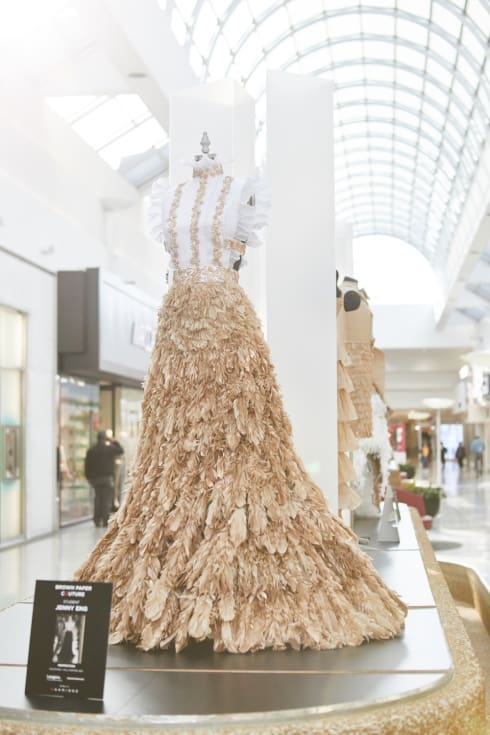The fashion fiend in us was ecstatic to discover that, between now and March 27th, 2018, a unique exhibit is being held at Vancouver’s Oakridge Centre, in partnership with the Langara College Design Formation Program. Students from the program designed "brown paper haute couture" gowns using only materials like recycled paper, coffee filters, cardboard and twine, and these amazing works are on public display! We chatted with Langara student Jenny Eng about her incredible creation (based on a 2016 Valentino Fall/Winter Haute Couture dress) and what it took to achieve it. —Noa Nichol
Hi Jenny! For starters, please tell us a bit about yourself!
My name is Jenny "JJ" Eng and I am a first-year multi-disciplinary design student at Langara’s Design Formation program. We learn to work in the visual merchandising, graphic, interior and exhibit design fields. I majored in geography, environment and sustainability at UBC and came to Design Formation because it offered a broad range of design fields that appealed to the non-academic design-curious side of me. I wanted something more interdisciplinary and hands on.
Can you tell us a it about this upcoming event you’re involved with at Oakridge, and explain what "brown paper haute couture" is/means?!
Brown Paper Couture is a pivotal project in Design Formation’s Retail Visual Presentation course. Here, we transformed a curated selection of famous designer haute couture dresses into marvellous paper sculpture creations, all under a five-week period. We were restricted to the use of a limited selection of humble materials, which include cardboard, craft paper, dressmaker’s tissue, paper tape, packaging tape, paper cord, coffee filters, cupcake liners, packaging tape, straight pins and string. The colour brown inherent in these materials is central to the Brown Paper Couture project. Each student’s paper dress involved extensive material exploration, creative problem solving and meticulous construction in order to keep the integrity of the inspiration.
And what about your creation specifically? What is it, what was the inspiration behind it, and what did you use to create it?
I choose a 2016 Valentino Fall/Winter Haute Couture dress and did my best to make my paper rendition a fully wearable dress out of the materials provided. Although this is primarily a brown paper dress project, the high contrast of black and white in the original dress made it definite for me that white needed to be present in my recreation. Therefore, I did a white tissue paper pleated top, ruffled shoulder straps and collar. To replicate the intricate beading, I manipulated and layered beads made by squeezing a very hot glue gun to make the shapes I thought best represented the actual form. Afterwards, I spray painted them gold for colour contrast and to match the feathered skirt. The skirt is covered with three sizes of paper feathers with short round ones up top to longer wispier ones below. Each feather is made with 5 layers of brown tissue paper glued together and attached behind with a floral wire hook so when placed on the skirt, the feathers would sway when worn. I sprayed a delicate coating of gold spray paint over each feather to give it that shimmery magic of a real feather. The bottom third of the skirt is detachable to prevent damage when transporting the dress around. I designed the entire dress to be wearable so the bands of the top and skirt are reinforced to make sure repeated de/attachments would not damage the dress.
What was your biggest challenged in making this creation?
The biggest challenge in making this dress is time management. Just within this program, we generally have four projects going on at once, in addition to other classes, extracurricular obligations and work. Besides that, making of skirt proved more difficult than I imagined. It begins slender and tight at the waist and gradually widens into a skirt with a trailing behind. There were at least six mockups for the skirt alone.
Beyond the skill/design of it, what, to you, is the significance of creating something from what may be considered by many people to be "scrap" or "waste" materials?
I do not believe people think that brown craft paper, coffee filters or cardboard and such are secondary materials. I think most people continually use and appreciate these materials because of their inherent strength, malleability and versatility. Here, the significance arises from the product created from modest materials instead of being the container for a product. I practised a great deal of divergent thinking from my material explorations to achieve a product that looks like an actual dress, not one made out of paper. My own explorations and general curiosity gave way to creating new techniques to best resolve my classmates’ dress difficulties. I helped a classmate create pieces of how her detachable skirt could be made into voluminous wavy curves. For another classmate, I developed a string wrapping and paper rope manipulation technique, from which she repeated to make her entire dress. I also learned that you could manipulate glue to make almost any shape you want if you create a cookie-cutter like mould out of wire or string and fill it in with glue.
Did you learn any lessons, as a designer or otherwise, in creating this piece?
As a designer in training, I learned that creating a supportive environment that encourages curiosity in exploration, opens up to collaboration, productivity and a lot of fun!




Be the first to comment